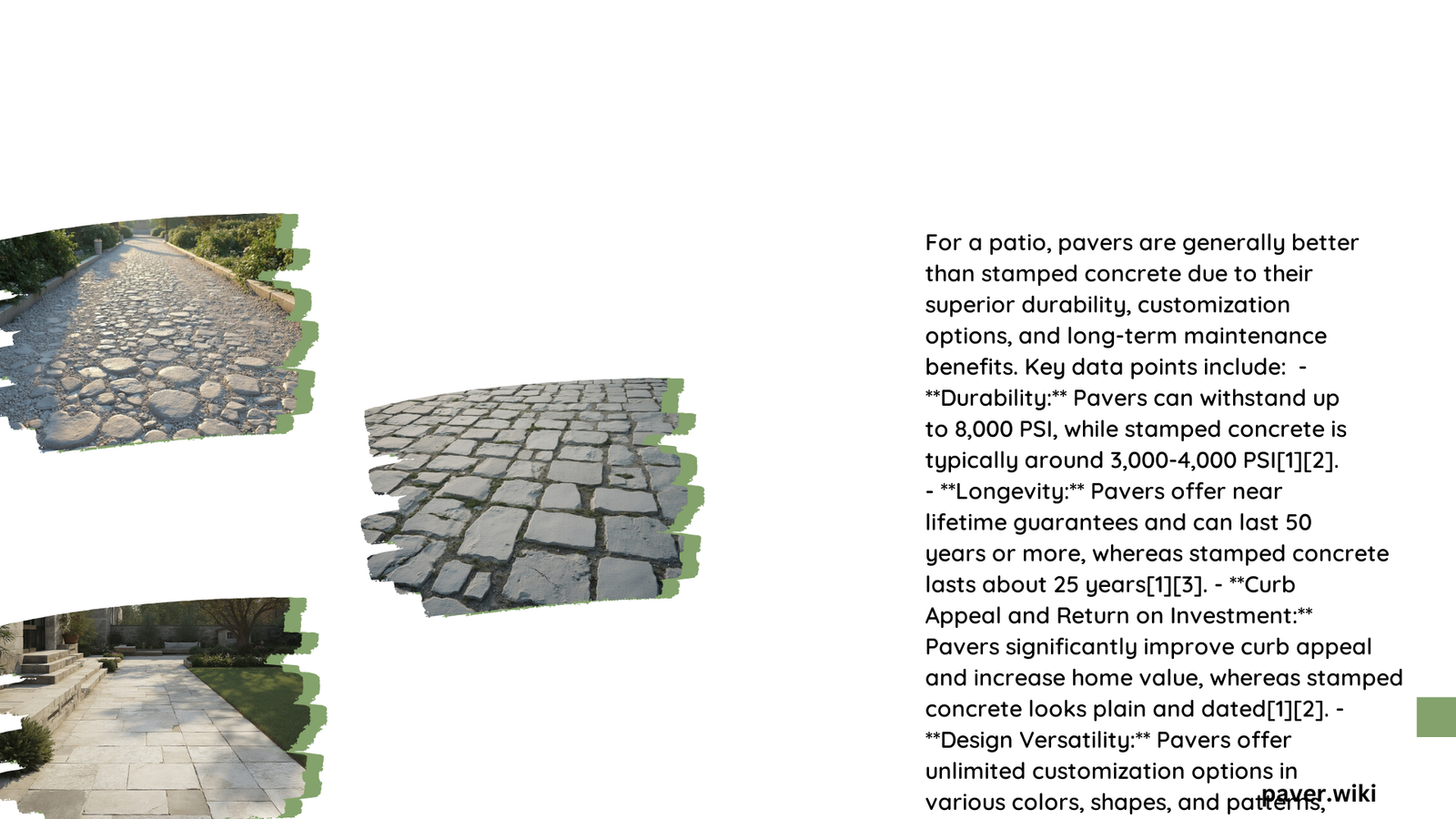When choosing between pavers and stamped concrete for a patio, several factors come into play. Pavers offer superior durability, lasting up to 50 years with proper care, and are more resistant to cracking. They handle weather extremes better and can increase home value. Stamped concrete, while less durable, provides a wider range of aesthetic options and is often less expensive initially. However, it requires more frequent maintenance and is more prone to cracking. The choice depends on individual preferences, budget, and long-term considerations.
What Are the Key Differences in Durability Between Pavers and Stamped Concrete?
Lifespan Comparison
- Pavers:
- Can last up to 50 years or more
- Maintain structural integrity over time
-
Resistant to extreme weather conditions
-
Stamped Concrete:
- Typically lasts 30+ years with proper maintenance
- More susceptible to cracking and weather damage
- May require more frequent repairs
Resistance to Cracking
Pavers have a distinct advantage when it comes to crack resistance. Their individual units allow for flexibility and movement without causing visible damage. This characteristic is particularly beneficial in areas with freeze-thaw cycles or shifting ground conditions.
Stamped concrete, on the other hand, is more prone to cracking over time. Despite the use of control joints, the continuous surface can develop cracks due to various factors such as temperature changes, ground movement, or heavy loads.
Weather Performance
| Aspect | Pavers | Stamped Concrete |
|---|---|---|
| Freeze-Thaw Cycles | Highly resistant | More susceptible to damage |
| Load Bearing | Up to 8,000 PSI | Around 4,000 PSI |
| Color Retention | Better long-term color stability | May fade or degrade over time |
How Do Installation Costs Compare Between Pavers and Stamped Concrete?

The initial cost of installation is often a crucial factor in deciding between pavers and stamped concrete. Here’s a breakdown of the typical costs:
- Stamped Concrete:
- Range: $8 to $18 per square foot (installed)
- Lower end: Simple patterns and colors
-
Higher end: Complex designs and multiple colors
-
Pavers:
- Range: $7 to $20 per square foot (installed)
- Factors affecting cost:
- Material type (concrete, brick, natural stone)
- Pattern complexity
- Site preparation requirements
While stamped concrete may seem less expensive initially, it’s important to consider long-term costs as well.
What Are the Long-Term Maintenance Expenses for Each Option?
Stamped Concrete Maintenance
- Regular sealing (every 1-2 years)
- Potential crack repairs
- Color touch-ups or reapplication
Paver Maintenance
- Occasional sand replacement between joints
- Less frequent sealing (every 3-5 years, depending on material)
- Easy individual paver replacement if damaged
Over time, the maintenance costs for stamped concrete can accumulate, potentially surpassing the initial savings compared to pavers.
How Do Pavers and Stamped Concrete Affect Home Resale Value?
The impact on home value is an important consideration when choosing between pavers and stamped concrete:
- Pavers:
- Generally increase home value more significantly
- Perceived as a high-quality, long-lasting investment
-
Attractive to potential buyers due to durability and aesthetic appeal
-
Stamped Concrete:
- Can improve backyard appearance
- Typically seen as less valuable than pavers in terms of resale value
- May be less appealing to buyers concerned about long-term maintenance
What Aesthetic Options Does Stamped Concrete Offer?
Stamped concrete provides a wide array of design possibilities:
- Stone-like patterns (slate, flagstone, cobblestone)
- Brick patterns
- Wood plank designs
- Custom textures and patterns
Color options include:
– Integral color (mixed into the concrete)
– Color hardeners (applied to the surface)
– Release agents (for accent colors and antiquing effects)
This versatility allows homeowners to achieve a desired look that complements their home’s architecture and landscape design.
How Easy Are Repairs for Pavers vs. Stamped Concrete?
Paver Repairs
- Individual damaged pavers can be easily replaced
- Minimal disruption to the overall patio surface
- Repairs are often less noticeable
Stamped Concrete Repairs
- Cracks can be challenging to repair without visible evidence
- Matching the original pattern and color can be difficult
- Large cracks may require extensive repairs or replacement of entire sections
The ease of repair is a significant advantage for pavers, contributing to their lower long-term maintenance costs and better overall durability.
What Are the Environmental Considerations for Each Option?
When considering the environmental impact:
- Pavers:
- Often made from permeable materials, allowing water to seep through
- Can reduce runoff and contribute to groundwater recharge
-
Individual units can be reused or recycled
-
Stamped Concrete:
- Impermeable surface that contributes to runoff
- Requires more resources for large-scale repairs or replacement
- Some options for using recycled materials in the concrete mix
Environmentally conscious homeowners may prefer pavers for their potential to create permeable surfaces and their reusability.
In conclusion, while both pavers and stamped concrete have their merits, pavers generally offer superior durability, easier maintenance, and better long-term value. Stamped concrete provides more design flexibility and can be less expensive initially, but may require more upkeep over time. The choice ultimately depends on individual priorities, budget constraints, and specific project requirements.
References:
- Omnipools and Scapes – Are Stamped Concrete Patios More Durable Than Pavers?
- JGudiell Landscape – Stamped Concrete vs. Pavers: A Comprehensive Comparison
- WLM Inc. – Pros and Cons of Stamped Concrete vs Pavers
- RNR Stone Works – Pavers Vs. Stamped Concrete: There’s a Clear Winner
- Concrete Network – Stamped Concrete vs. Pavers – What’s Best? What Costs Less?
